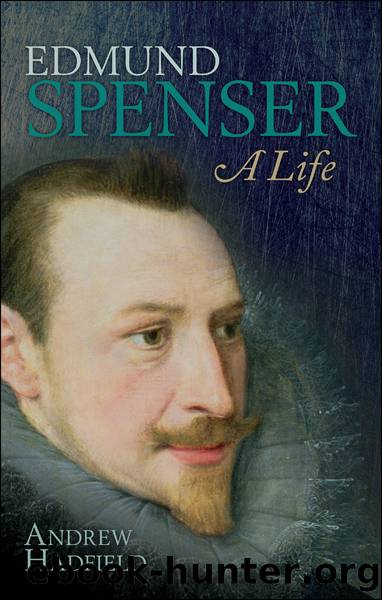Edmund Spenser by Andrew Hadfield

Author:Andrew Hadfield
Language: eng
Format: epub
Publisher: Oxford University Press
Published: 2012-07-14T16:00:00+00:00
If blinde men could of costlie colours iudge,
and intermeddle with Apelles arte,
Or were not fretting Enuie giuen to grudge
the faith of him who places a freindlie paste,
Or if my skill could see in causes deepe,
I would reueale what nowe I secreate keepe
Therefore, Joan Boyle’s second husband must surely have been the gentleman of Huntingdon who had taken part in an identical transaction to the one outlined here between the Drydens and the Spencers of Althorp in 1591–2, preserved ‘in the Exchequer of George Dryden of Adson alias Adneston co. Northamp. gent.’: ‘Whereas Ferdinando Freckleton of Huntington gent became bound to me 25 October 28 Eliz. in 200 £to secure 100 £; and Whereas Sir John Spencer of Althorpe Kt is indebted to the Queen in divers sums of money—to assign Freckleton’s bond on security in behalf of Sir John Spencer—28 April 34 Eliz. 1592.’158 This is further evidence of a connection between the Boyle family and Freckleton, as the grandfather of Joan Boyle, née Cope, had married Jane Spencer, granddaughter of John Spencer of Hodnell, Warwickshire.159 Freckleton may have been put forward as a husband for Joan after she was widowed as a means of keeping the family together and so preserving its property.
The Chancery case also raises a host of issues relating to Spenser’s life. If nothing else, it shows that he now had—assuming he had not before—a vested interest in the Bradden–Canons Ashby area of Northamptonshire. It also suggests that he was now relied upon to take the lead in family matters by his wife and her brothers, as we might expect given his age, status, and legal knowledge. What we cannot know is for how much of the case Spenser and his wife were present; whether the case signalled a permanent break with the Freckletons; whether those family members who lived in Ireland travelled back to Northamptonshire to attend the various proceedings; nor, indeed, how many of them lived there anyway. It does provide yet more information about the social and familial networks in which Spenser existed, indicating that local contexts were especially important for him and that he lived at least one remove from the established gentry, as did the Northamptonshire Boyles. The case, as made practical sense, was heard locally, further evidence provided by the fact that the replication of the Boyles was lodged in Clapham, a village about twenty miles from Northampton. The documents also show that the Spensers were not—and probably could not be—careless with money and felt that he needed to ensure that they kept what they held.
They also indicate that Spenser may have fostered a link with Egerton, a powerful figure whose stock was still rising, as on 6 May of that year he was made Lord Keeper to succeed Sir John Puckering, probably as a result of the queen’s intervention, retaining the Mastership of the Rolls.160 The Egertons were Catholics, Sir Thomas only converting to Protestantism in the early 1580s, another indication of the close interaction of people on either side of the religious divide in early modern England.
Download
This site does not store any files on its server. We only index and link to content provided by other sites. Please contact the content providers to delete copyright contents if any and email us, we'll remove relevant links or contents immediately.
| African | Asian |
| Australian & Oceanian | Canadian |
| Caribbean & Latin American | European |
| Jewish | Middle Eastern |
| Russian | United States |
4 3 2 1: A Novel by Paul Auster(12281)
The handmaid's tale by Margaret Atwood(7678)
Giovanni's Room by James Baldwin(7188)
Asking the Right Questions: A Guide to Critical Thinking by M. Neil Browne & Stuart M. Keeley(5631)
Big Magic: Creative Living Beyond Fear by Elizabeth Gilbert(5610)
Ego Is the Enemy by Ryan Holiday(5292)
The Body: A Guide for Occupants by Bill Bryson(4973)
On Writing A Memoir of the Craft by Stephen King(4863)
Ken Follett - World without end by Ken Follett(4643)
Adulting by Kelly Williams Brown(4485)
Bluets by Maggie Nelson(4472)
Eat That Frog! by Brian Tracy(4430)
Guilty Pleasures by Laurell K Hamilton(4358)
The Poetry of Pablo Neruda by Pablo Neruda(4038)
Alive: The Story of the Andes Survivors by Piers Paul Read(3967)
White Noise - A Novel by Don DeLillo(3953)
Fingerprints of the Gods by Graham Hancock(3938)
The Book of Joy by Dalai Lama(3897)
The Bookshop by Penelope Fitzgerald(3775)
